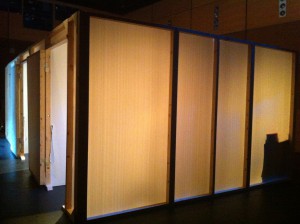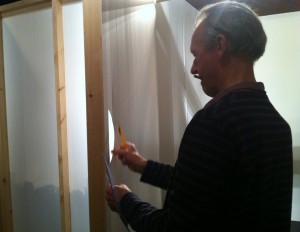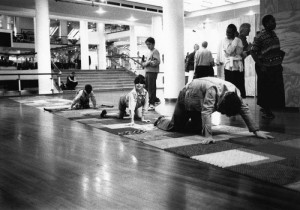 If you get to see Janice Parker’s Private Dancer, her commission for the London 2012 Festival, the first thing you will notice is the House. Part set, part sculpture, the installation is the construction that houses the five rooms in which the private dances take place, but its more than that too. Its actually a self supporting structure that offers both safety and risk, that both underscores and amplifies the piece, subtly holding the hands of both the performers and the audience simultaneously. Not bad for a building.
If you get to see Janice Parker’s Private Dancer, her commission for the London 2012 Festival, the first thing you will notice is the House. Part set, part sculpture, the installation is the construction that houses the five rooms in which the private dances take place, but its more than that too. Its actually a self supporting structure that offers both safety and risk, that both underscores and amplifies the piece, subtly holding the hands of both the performers and the audience simultaneously. Not bad for a building.
It has been designed by performance artist Richard Layzell whose work has been attracting attention since his time as as a student at the Slade School of Fine Art in the 1970s. His interests and areas of focus are wide and include: environmental and gender issues; architectural space; performativity; the gallery context; the nature of interior dialogue; experiential learning; expanding the audience for contemporary practice and exploring the public realm – almost all of which come into play within Private Dancer.
Centre for Research into Creation in the Performing Arts describes his work as follows:
The common threads of Richard’s practice and research are essentially about an engagement with opportunity. This takes many forms: a floor to be dismantled; a city to be re-examined; a gesture to be defined; a cultural interface with the nature of work and industry; a political campaign; a collaboration with six year olds; an intensive study of the foxglove.
 The House certainly provides and plays with such opportunities. As a space it is both physical and symbolic. It has been designed with the ideas of control and power which are central to Janice’s work built into its framework. It is luminescent – inviting but also unknown. Interestingly it holds a duality – people can’t help but feel welcomed by it, but also slightly intimidated. Not everyone gets invited right into the structure, and yet when the invitation to enter is offered, some people feel too scared to experience the degree of intimacy it creates.
The House certainly provides and plays with such opportunities. As a space it is both physical and symbolic. It has been designed with the ideas of control and power which are central to Janice’s work built into its framework. It is luminescent – inviting but also unknown. Interestingly it holds a duality – people can’t help but feel welcomed by it, but also slightly intimidated. Not everyone gets invited right into the structure, and yet when the invitation to enter is offered, some people feel too scared to experience the degree of intimacy it creates.
 This is not the first time Richard has created work linked to disability. In 1996 he created an installation aimed at sensory impaired people for the Royal Festival Hall called Tap, Ruffle and Shave. This had an invitation to all, but was specifically aimed at disabled people and was beautifully described in its by line: ‘an installation to meddle with’.
This is not the first time Richard has created work linked to disability. In 1996 he created an installation aimed at sensory impaired people for the Royal Festival Hall called Tap, Ruffle and Shave. This had an invitation to all, but was specifically aimed at disabled people and was beautifully described in its by line: ‘an installation to meddle with’.I think, for me – and for Janice – it not just a dance, it’s an experience. When the audience are there it changes and becomes about their experience, and I introduce what their experience can be. And it can be many things. It can be about what they experience in a room, it can be just as valid if they don’t go in any rooms at all. Is it dance, is it live arts? I think its between them both – but then again, describing it as either isn’t quite right. Its just Private Dancer.